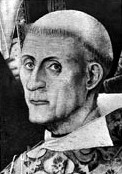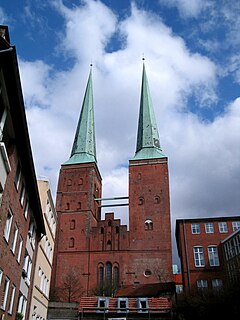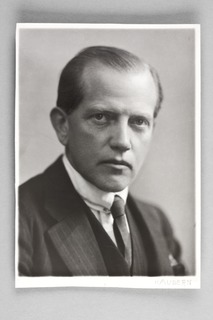
Henning van der Heide (sometimes von der Heide/Heyde, ca. 1460 - 1521) was a German late Gothic sculptor.

Henning van der Heide (sometimes von der Heide/Heyde, ca. 1460 - 1521) was a German late Gothic sculptor.
Little is known about van der Heide's personal life. He was trained in the workshop of Bernt Notke (and worked with him on his famous Saint George and the Dragon statue in Stockholm) [1] and seems to have lived and worked in Lübeck, present-day Germany. In 1485 he married, and in 1487 he purchased a house in Königstraße street of Lübeck. In 1513 he was made alderman at the guild of painters. He seems to have retired in 1519, when his workshop passed to his oldest son. For a craftsman of his age he appears to have been unusually wealthy as he managed to purchase three houses, one for each of his sons. [2] [3] [4]
His works are often confusingly similar to those of Notke, and scholars debate about what works should be assigned to which artist. As a rule, however, van der Heide seem to have added more individuality to his portraits and less emotionally overstated. [4] Works attributable to van der Heide include altarpieces in Brændekilde church, Denmark [5] and in Saaremaa Museum, Estonia (previously in Kaarma church); [6] the Saint George and the Dragon group currently in the St. Anne's Museum, Lübeck; [2] [4] a sculpture of St. Jerome in Vadstena Abbey, Sweden; [4] a sculpted head of St. John the Baptist currently in the Swedish Museum of National Antiquities, [7] and others.

John was a Scandinavian monarch under the Kalmar Union. He was king of Denmark (1481–1513), Norway (1483–1513) and as John II Sweden (1497–1501). From 1482 to 1513, he was concurrently duke of Schleswig and Holstein in joint rule with his brother Frederick.

A rood or rood cross, sometimes known as a triumphal cross, is a cross or crucifix, especially the large crucifix set above the entrance to the chancel of a medieval church. Alternatively, it is a large sculpture or painting of the crucifixion of Jesus.


St. Anne's Museum Quarter was previously an Augustinian nunnery, St. Anne's Priory. Since 1915 it has housed St. Anne's Museum, one of Lübeck's museums of art and cultural history containing Germany's largest collection of medieval sculpture and altar-pieces, including the famous altars by Hans Memling, Bernt Notke, Hermen Rode, Jacob van Utrecht and Benedikt Dreyer.

The Battle of Brunkeberg was fought on 10 October 1471 between the Swedish regent Sten Sture the Elder and forces led by Danish king Christian I. Sture won a decisive victory.

St. Mary's Church in Lübeck was built between 1250 and 1350. It has always been a symbol of the power and prosperity of the old Hanseatic city, and is situated at the highest point of the island that forms the old town of Lübeck. It is part of the UNESCO World Heritage Site of the old Hanseatic City of Lübeck.

Lübeck Cathedral is a large brick-built Lutheran cathedral in Lübeck, Germany and part of the Lübeck World Heritage Site. It was started in 1173 by Henry the Lion as a cathedral for the Bishop of Lübeck. It was partly destroyed in a bombing raid in World War II (1942), when the Arp Schnitger organ was destroyed by fire, but was subsequently reconstructed.

Swedish art refers to the visual arts produced in Sweden or by Swedish artists. Sweden has existed as country for over 1,000 years, and for times before this, as well as many subsequent periods, Swedish art is usually considered as part of the wider Nordic art of Scandinavia. It has, especially since about 1100, been strongly influenced by wider trends in European art. After World War II, the influence of the United States strengthened substantially. Due to generous art subsidies, contemporary Swedish art has a big production per capita.
Hermen Rode was a German Gothic painter.

St. Nicholas Church is a medieval former church in Tallinn, Estonia. It was dedicated to Saint Nicholas, the patron of the fishermen and sailors. Originally built in the 13th century, it was partially destroyed in the Soviet bombing of Tallinn in World War II. It has since been restored and today houses the Niguliste Museum, a branch of the Art Museum of Estonia, focusing mainly on ecclesiastical art from the Middle Ages onward. The former church is also used as a concert hall.

John (Johnny) August Emanuel Roosval was a Swedish art historian, Medieval ecclesiastical art specialist, and university professor.
Switzerland participated at the Eurovision Song Contest 2010, that was held in Oslo, Norway. On 18 December SRG SSR idée suisse, following internal selection again, announced that they had selected Swiss singer Michael von der Heide to represent the country with "Il pleut de l'or", sung in French.

Kaarma-Kirikuküla is a village in Saaremaa Parish, Saare County in western Estonia. As of 2011 Census, the settlement's population was 18.

The Dano-Swedish War was the first war between Denmark and Sweden. The Danes invaded Sweden by sea, but were defeated early at the Battle of Brunkeberg, in which King Christian I of Denmark was wounded by a cannonball. The Danish invasion was repelled, and the Swedes were independent from the Kalmar Union.
Carl Georg Heise was a German art historian. From 1945 to 1955 he was director of the Kunsthalle Hamburg.
The following is a timeline of the history of the city of Lübeck, Schleswig-Holstein, Germany.

Danse Macabre is a painting by Bernt Notke. A fragment of the late fifteenth-century painting, originally some 30 meters wide, is displayed in the St. Nicholas Church, Tallinn. It is regarded as the best-known and as one of the most valuable medieval artworks in Estonia. It is the only surviving medieval Dance Macabre in the world painted on canvas.

Saint George and the Dragon is a late medieval wooden sculpture depicting the legend of Saint George and the Dragon, located in Storkyrkan in Stockholm, Sweden. It is attributed to Bernt Notke and was commissioned by the Swedish regent Sten Sture the Elder. It was inaugurated in 1489. It has been described as an artistic high point in the artistic production of Bernt Notke.

The sculptural group of The Holy Trinity is a work by an anonymous sculptor called the Master of the Žebrák Lamentation of Christ dating from the period after 1512. Christian Salm considers this work and others by the Master of the Žebrák Lamentation of Christ to be some of the finest Gothic sculptures of their time. The sculpture of the Holy Trinity is on display in the permanent collection of the Aleš South Bohemian Gallery in Hluboká nad Vltavou.
Heide is a surname and feminine given name. Heide is a German and Dutch word meaning "heath".